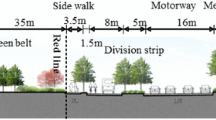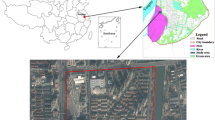Abstract
Building a rainwater system based on the idea of low-impact development (LID) is an important aspect of the current “sponge city” construction in China. The “sponge city” concept emphasizes that the runoff can permeate the soil or be stored temporarily, and rainwater could be used again when it is needed. Bei**g is one of the earliest cities to study rainwater harvesting and LID techniques in China. Through long-term monitoring of rainfall, runoff flow, and water quality of a campus demonstration project in Bei**g, the runoff quantity and pollutant concentration variations have been analyzed. Furthermore, the runoff reduction effects of single LID measure, such as green roof, filtration chamber, and permeable pavement, have been investigated. Additionally, the overall reduction effectiveness of the LID system on the average annual rainfall runoff and pollution load has been discussed. Preliminary studies suggest that runoff pollutant concentration is positively correlated with the rainfall interval time, and the longer rainfall interval time leads to higher runoff pollutant concentrations. The very good outflow quality of the rainwater harvesting system could satisfy the reclaimed water quality standard for scenic entertainment use. The non-point-source pollution reduction effects of the LID system are obvious because the pollutants could be removed by filtration on the one hand and the pollution load could be reduced because of the significantly reduced outflow on the other hand.

Similar content being viewed by others

References
Dietz M E. Low impact development practices: a review of current research and recommendations for future directions. Water, Air, and Soil Pollution, 2007, 186(1): 351–363
Khan S, Stenstorm M K, Lau S L, Kayhanian M. Oil and grease measurement in highway runoff-sampling time and event mean concentrations. Journal of Environmental Engineering, 2006, 132 (3): 415–422
Mcduffie E, Mallari N, Pate D, Smith B, Zeder L M. A study of ecosystem services provided by a storm water retrofit system on a public school campus in orange county, North Carolina. Sustainability the Journal of Record, 2015, 8(2): 85–94
Walsh C J, Kunapo J. The importance of upland flow paths in determining urban effects on stream ecosystems. Freshwater Science, 2009, 28(4): 977–990
Chow M F, Yusop Z, Shirazi S M. Storm runoff quality and pollutant loading from commercial, residential, and industrial catchments in the tropic. Environmental Monitoring and Assessment, 2013, 185(10): 8321–8331
Li W, Shen Z, Tian T, Liu R, Qiu J. Temporal variations of heavy metal pollution in urban stormwater runoff. Frontiers of Environmental Science & Engineering, 2012, 6(5): 692–700
Wengrove M E, Ballestero T P. Upstream to downstream: storm-water quality in Mayagüez, Puerto Rico. Environmental Monitoring and Assessment, 2012, 184(8): 5025–5034
Environmental Protection Agency. Water: Outreach & Communication-Nonpoint Source Pollution: The Nation’s Largest Water Quality Problem. http://water.epa.gov/polwaste/nps/outreach/ point1.cfm (last accessed 01/18/2017)
Schueler T, Claytor R. Maryland Stormwater Design Manual. Maryland Department of the Environment Baltimore, MD, 2000
United States Environmental Protection Agency. Storm Water Technology Fact Sheet. Washington, DC; USEPA, 1999, 1–10
Jia H F, Yao H R, Yu SL. Advances in LID BMPs research and practices for urban runoff control in China. Frontiers of Environmental Science & Engineering, 2013, 7(5): 709–720
Burns M J, Fletcher T D, Walsh C J, Ladson A R, Hatt B E. Hydrologic shortcomings of conventional urban stormwater management and opportunities for reform. Landscape and Urban Planning, 2012, 105(3): 230–240
Burns M J, Fletcher T D, Duncan H P, Hatt B E, Ladson A R,Walsh C J. The performance of rainwater tanks for stormwater retention and water supply at the household scale: an empirical study. Hydrological Processes, 2015, 29(1): 152–160
Thomas N D, Andrew J R. Municipal Stormwater Management. Washington, DC: Lewis Publishers, 2002.
Mu H Z, Zheng T, Huang Y C, Zhang C P, Liu C. Reducing nonpoint source pollution with enhancing infiltration. Journal of Environmental Sciences (China), 2006, 18(1): 115–119
Murakami M, Sato N, Anegawa A, Nakada N, Harada A, Komatsu T, Takada H, Tanaka H, Ono Y, Furumai H. Multiple evaluations of the removal of pollutants in road runoff by soil infiltration. Water Research, 2008, 42(10-11): 2745–2755
Davis A P, Shokouhian M, Sharma H, Minami C. Water quality improvement through bioretention media: nitrogen and phosphorus removal. Water Environment Research, 2006, 78(3): 284–293
Chen C F, Lin J Y, Chen Y L. Evaluating LID runoff control efficiency in Taipei Tech Eco-campus with SUSTAIN model. 2013 International Low Impact Development Symposium, 2013. (in Chinese)
Jia H, Wang X, Ti C, Zhai Y, Field R, Tafuri A N, Cai H, Yu S L. Field monitoring of a LID-BMP treatment train system in China. Environmental Monitoring and Assessment, 2015, 187(6): 373
Ihsan M, Setiawan B I, Pandjaitan N H. Design of zero runoff system at IPB Darmaga Campus, Bogor, West Java. Jurnal TeknikSipil Dan Lingkungan, 2016, 1(1): 1–9
Stevens H. Stormwater Retrofit at Mt. Tabor Middle School: Lessons Learned about Designing Landscape Systems at Schools. International Low Impact Development Conference, 2014(333): 1–10
Zhao R, Zhang S H, Chen J G. Low-impact development of campus rainwater system application case study. China Flood Control and Drought, 2010, 5 (25): 80–82 (in Chinese)
Zhao J Q. Urban Surface Runoff Pollution and Control. Bei**g: China Environmental Science Press, 2002 (in Chinese)
Acknowledgements
This work was supported by the National Major Science and Technology Program (Grant No. 2013ZX07304-001) and the National Science Foundation of Bei**g (Grant No. 8161002).
Author information
Authors and Affiliations
Corresponding author
Rights and permissions
About this article
Cite this article
Zhang, S., Meng, Y., Pan, J. et al. Pollutant reduction effectiveness of low-impact development drainage system in a campus. Front. Environ. Sci. Eng. 11, 14 (2017). https://doi.org/10.1007/s11783-017-0969-8
Received:
Revised:
Accepted:
Published:
DOI: https://doi.org/10.1007/s11783-017-0969-8



